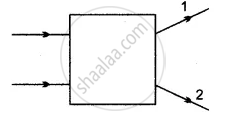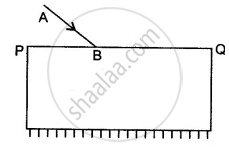Advertisements
Advertisements
Question
An object 5 cm high is held 25 cm away from a converging lens of focal length f = 10 cm. Draw a suitable scale diagram and find the position and size of me image formed is the image real or virtual?
Solution
First of all, we should note that a converging lens is a convex lens. Since the distance given in this problem are quite large and inconvenient to draw in the note-book, so we have to choose a suitable scale. Let 1 cm represent a distance of 5 cm.
On this scale:
(i) A 5 cm high object can be represented by 1 cm.
(ii) Object distance of 25 cm can be shown by 5 cm.
(iii) Focal length of 10 cm can be represented by 2 cm.
Keeping these distances in mind, we will draw the ray-diagram now.

First of all, draw a horizontal line to represent the principal axis of the convex lens. A convex lens is then drawn with its optical centre C on the axis. The (centre line) aperture of the convex lens has been shown by the line DE. We assume that the refraction of light takes place at the aperture. The focal length of this lens is 2 cm, so we mark its two focal F’ and F at a distance of 2 cm on both the sides of the lens. And to represent the object, we draw an arrow AB, 1 cm high at a distance of 5 cm from the centre C of the lens on its left side.
In order to find out the position of the image, we draw two rays of light starting from the top point A of the object. The line AD is drawn parallel to the principal axis to represent a parallel ray of light. This ray cuts the aperture at a point P. Now, this parallel ray of light will pass through the focus F. So we join D and F by a straight line and produce this line further towards X. Thus, DX represents the first refracted ray. We now draw the second ray of light passing through the optical centre C of the lens which goes straight without any deviation.
For this purpose, we join AC and produce it further downwards towards Y. Now, CY represents the second refracted ray The two refracted rays DX and CY meet at point A’. We draw A’B’ perpendicular to the principal axis. Now A’B’ represents the real and inverted image of the object AB.
(i) To find the position of the image, we measure the distance CB’. It is found to be 3.3 cm. And to obtain the actual position of the image we have to multiply this distance by 5. Since 1 cm represents a distance of 5 cm. Thus the position of the image is 3.3 × 5 = 16.5 cm from the convex lens on the opposite side of the object.
(ii) If we look at the image formed in the figure, we find that the nature of the image is real and inverted.
(iii) And to find the size of the image, we measure the height A’B’ in the figure. It is found to be 0.7 cm. For obtaining the actual size of the image, we have to multiply it by 5. Thus, the size of image is 0.7 × 5 = 3.5 cm. So, the image is smaller than the object i.e., diminished.
APPEARS IN
RELATED QUESTIONS
Figure shows the transmitted rays through lens kept in a box. Draw the lens and complete the path of rays.

Figure show the incident rays through the lens kept in a box. Draw the lens and complete the path of rays.

The diagram on right shows a ray of white light AB incident on a rectangular glass block, which is silvered at the lower surface. This ray is partly reflected and partly refracted.

(i) Copy the diagram and trace the path of the refracted and reflected ray. Show at least two rays emerging from the surface ‘PQ’
(ii) How many images are formed in the above case? Which image is the brightest?
